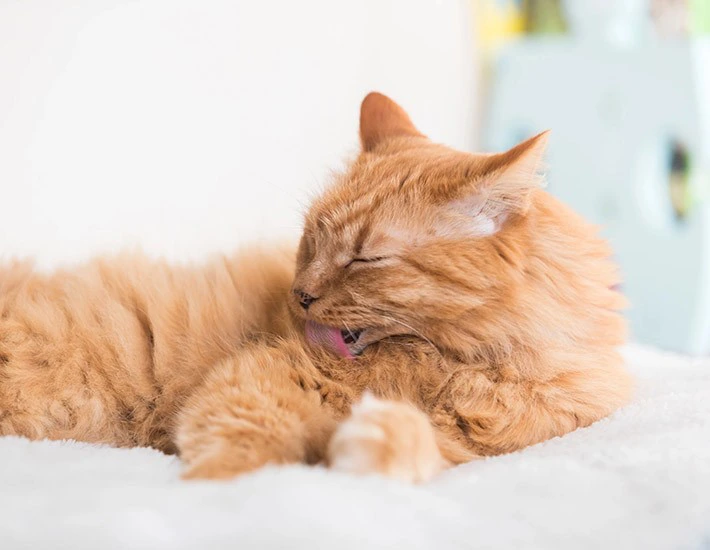Looking for more advice on feline vomiting? In this guide, you can find out more about the main causes, symptoms, and things you can do at home to help with occasional vomiting.
Just like humans, cats can vomit for many reasons. Vomiting is when cats experience nausea (feeling sick) and then bring up what’s in their stomach (which might be food and fluids, or even furballs).
Vomiting is different to regurgitation. Regurgitation is when food is eaten and is then ejected back out through the mouth, without reaching the stomach or being digested. It happens soon after eating, your cat won’t show signs of being nauseous or retching and although the food may be tube-shaped and covered in mucus, it will otherwise look similar to before it was eaten.
Regurgitation may be ‘normal’ in otherwise healthy cats who eat their food too quickly. However, it can also occur due to underlying health issues, so it is best to seek veterinary advice if your cat regurgitates repeatedly.
When your cat is about to vomit, they might begin to show signs of restlessness and agitation. This is usually followed by excessive swallowing, lip licking and salivating, and then strong movements of the abdomen. Because their stomach continuously contracts and it takes a lot of effort to throw up, it can be distressing to your cat and it would be best to let them finish and rest before trying to move them.
There are a lot of reasons why a cat might vomit and it is not unusual for cats to be sick occasionally.
If it only happens once and your cat is otherwise bright and healthy, with no other symptoms, they should recover quickly.
However, vomiting can also be a sign of underlying health issues and it can make your cat feel unwell, so always speak with your vet if you are concerned.
A common reason for cats to throw up is when they have consumed hair while grooming.
These hairs become entangled and irritate the stomach lining causing the fur to be thrown up in mucus covered hairballs. Not all cats will experience this and grooming your cat often can help to prevent this.
Regularly bringing up furballs can be a sign of other diseases within the stomach or intestines, or of the skin causing your cat to groom more.

If your cat vomits, you might notice that what they bring up can vary and you might be wondering what is considered ‘normal’.
Although furballs are most likely to be normal, all forms of vomit can indicate underlying disease.
Whether your cat vomits occasionally or more frequently, it is a good idea to mention any vomiting to your vet as there can be various underlying causes. Frequent or severe vomiting, and if your cat is not able to keep down food and water, requires an urgent vet examination.
Vomiting accompanied by other symptoms, such as a change in appetite or thirst, lethargy, diarrhoea and weight loss, should not be delayed in being checked by a vet. They are signs your cat could be unwell and this requires investigation and treatment.
Vomiting in very young or old animals is more likely to be significant or lead to secondary problems such as dehydration.
If you have kittens that have not been wormed, you might see parasites (worms) in their vomit, but this can happen to adult cats as well. This is not that common and would not be considered as normal and your vet should be contacted for advice.
Untreated parasite infections can be dangerous and should be treated as soon as possible. Occasionally, after administering a worming treatment, you may see dead worms in vomit or faeces/poo.

While there could be more serious causes of your cat’s vomiting which should be diagnosed by your vet, we have a few tips for you to try if your cat is healthy and experiences occasional throwing up: